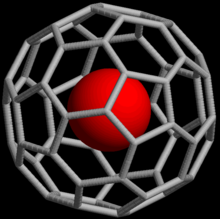Endohedral fullerene


Endohedral fullerenes, also called endofullerenes, are fullerenes that have additional atoms, ions, or clusters enclosed within their inner spheres. The first lanthanum C60 complex called La@C60 was synthesized in 1985.[2] The @ (at sign) in the name reflects the notion of a small molecule trapped inside a shell. Two types of endohedral complexes exist: endohedral metallofullerenes and non-metal doped fullerenes.
Notation
In a traditional chemical formula notation, a buckminsterfullerene (C60) with an atom (M) was simply represented as MC60 regardless of whether M was inside or outside the fullerene. In order to allow for more detailed discussions with minimal loss of information, a more explicit notation was proposed in 1991,[2] where the atoms listed to the left of the @ sign are situated inside the network composed of the atoms listed to the right. The example above would then be denoted M@C60 if M were inside the carbon network. A more complex example is K2(K@C59B), which denotes "a 60-atom fullerene cage with one boron atom substituted for a carbon in the geodesic network, a single potassium trapped inside, and two potassium atoms adhering to the outside."[2]
The choice of the symbol has been explained by the authors as being concise, readily printed and transmitted electronically (the at sign is included in ASCII, which most modern character encoding schemes are based on), and the visual aspects suggesting the structure of an endohedral fullerene.
Endohedral metallofullerenes
Doping fullerenes with electropositive metals takes place in an
In 1999 a discovery drew large attention. With the synthesis of the Sc3N@C80 by
Endohedral metallofullerenes are characterised by the fact that electrons will transfer from the metal atom to the fullerene cage and that the metal atom takes a position off-center in the cage. The size of the
The lack of reactivity in
In Ce2@C80 the two metal atoms exhibit a non-bonded interaction.[4] Since all the six-membered rings in C80-Ih are equal[4] the two encapsulated Ce atoms exhibit a three-dimensional random motion.[5] This is evidenced by the presence of only two signals in the 13C-NMR spectrum. It is possible to force the metal atoms to a standstill at the equator as shown by x-ray crystallography when the fullerene is exahedrally functionalized by an electron donation silyl group in a reaction of Ce2@C80 with 1,1,2,2-tetrakis(2,4,6-trimethylphenyl)-1,2-disilirane.
Gd@C82(OH)22, an endohedral metallofluorenol, can competitively inhibit the WW domain in the oncogene YAP1 from activating. It was originally developed as an MRI contrast agent.[6][7]
Non-metal doped fullerenes
Endohedral complexes He@C60 and Ne@C60 are prepared by pressurizing C60 to ca. 3 bar in a noble-gas atmosphere.[8] Under these conditions about one out of every 650,000 C60 cages was doped with a helium atom. The formation of endohedral complexes with helium, neon, argon, krypton and xenon as well as numerous adducts of the He@C60 compound was also demonstrated[9] with pressures of 3 kbars and incorporation of up to 0.1% of the noble gases.
While noble gases are chemically very inert and commonly exist as individual atoms, this is not the case for nitrogen and phosphorus and so the formation of the endohedral complexes N@C60, N@C70 and P@C60 is more surprising. The nitrogen atom is in its electronic initial state (4S3/2) and is highly reactive. Nevertheless, N@C60 is sufficiently stable that exohedral derivatization from the mono- to the hexa adduct of the malonic acid ethyl ester is possible. In these compounds no
The central atom in these endohedral complexes is located in the center of the cage. While other
Contrary to the metallo endohedral compounds, these complexes cannot be produced in an arc. Atoms are implanted in the fullerene starting material using
Noble gas endofullerenes are predicted to exhibit unusual polarizability. Thus, calculated values of mean polarizability of Ng@C60 do not equal to the sum of polarizabilities of a fullerene cage and the trapped atom, i.e. exaltation of polarizability occurs.,.[11][12] The sign of the Δα polarizability exaltation depends on the number of atoms in a fullerene molecule: for small fullerenes (), it is positive; for the larger ones (), it is negative (depression of polarizability). The following formula, describing the dependence of Δα on n, has been proposed: Δα = αNg(2e−0.06(n – 20)−1). It describes the DFT-calculated mean polarizabilities of Ng@C60 endofullerenes with sufficient accuracy. The calculated data allows using C60 fullerene as a Faraday cage,[13] which isolates the encapsulated atom from the external electric field. The mentioned relations should be typical for the more complicated endohedral structures (e.g., C60@C240[14] and giant fullerene-containing "onions" [15]).
Molecular endofullerenes
Closed fullerenes encapsulating small molecules have been synthesized. Representative are the synthesis of the dihydrogen endofullerene H2@C60, the water endofullerene H2O@C60, the hydrogen fluoride endofullerene HF@C60, and the methane endofullerene CH4@C60.[16][17][18][19] The encapsulated molecules display unusual physical properties which have been studied by a variety of physical methods.[20] As shown theoretically,[21] compression of molecular endofullerenes (e.g., H2@C60) may lead to dissociation of the encapsulated molecules and reaction of their fragments with interiors of the fullerene cage. Such reactions should result in endohedral fullerene adducts, which are currently unknown.
See also
- Fullerene ligands
- Inclusion compounds


